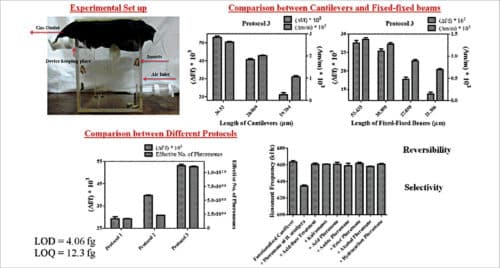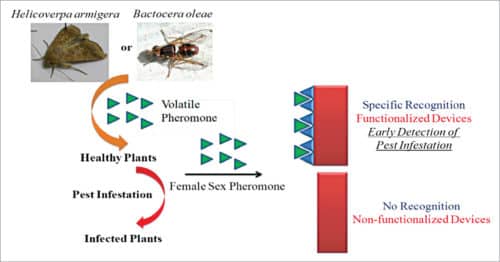A novel approach to detect chemical mating signals of hazardous crop pests, even at extremely low concentrations, thus prompting preventive measures to avoid crop losses
Globally, 20-40 per cent of crop yields are lost due to plant pests every year. In particular, Helicoverpa armigera (Hubner), Scirpophaga incertulas (Walker) and Bactrocera oleae pests are known to infect more than 150 crops across the world. These insects are particularly widespread in South Asia and the Mediterranean region. The female insects of these species release chemicals known as sex pheromones in the air for mating.
In this context, a group of scientists led by Prof. Santanu Bhattacharya, director, Indian Association for the Cultivation of Science (IACS), Kolkata, have developed a unique approach to detect the female sex pheromone of certain agriculturally hazardous pests and identify the prior infestation stage depending upon the pheromone concentration present in an agricultural field. Necessary action can then be taken to manage the pest infestation efficiently.
To accomplish this target, the scientists fabricated a few MEMS devices (Fig. 1) and then covalently functionalised them for selective sensing of a particular pheromone. Using these devices, they were able to detect the female sex pheromone of Helicoverpa armigera, Scirpophaga incertulas (Fig. 2) and Bactrocera oleae (Fig. 3)—the most known agriculturally hazardous pests globally.



The increase in pheromone mass was quantitatively sensed by a proportionate change in frequency or resistance, which was measured and monitored continuously (Fig. 4). Experiments were also performed with male and female Helicoverpa armigera pests in presence of tomato plants in a confined region that mimicked the real environmental conditions.

After selective detection of pheromone and prior to applying any measure to control the pest plague, a stage was identified where the pheromone concentration was just below the danger level. Necessary actions were then be taken as and when needed in a confined region of alerted pest attack. This also reduced the possibility of anthrapogenic contamination due to the current overuse of pesticides/insecticides.
These pheromone nanosensors show excellent efficacy and stability in open atmosphere, even during wet atmospheric conditions like rainy season or in peak summer under bright sunshine. This feature heightens their potential for commercial use in any season under ambient conditions. Again, the transportation of these pheromone nanosensors is trouble-free because of covalent bonding.

Overall, this is a novel bioengineering approach for selective and reversible sensing of female sex pheromones of certain hazardous pests, which may be efficiently and economically carried forward from the research laboratory to the agricultural field.






